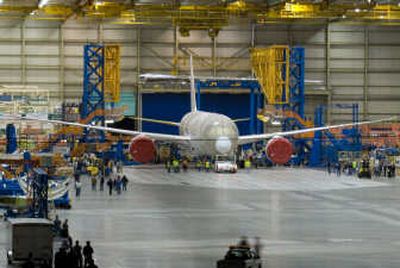Boeing’s lofty expectations

With the fanfare of a royal wedding and Tom Brokaw as emcee, Boeing Co. on Sunday will lift the veil on its first new passenger jet in more than a decade, ushering in what some analysts believe will be a new era in air travel.
More than 15,000 dignitaries and airline executives have been invited to the 787 “Dreamliner” rollout at Boeing’s massive Everett, Wash., plant, and an estimated 50,000 current and retired employees will watch on large screens at Qwest Field, home of the National Football League’s Seattle Seahawks.
Boeing officials hope that the extravagant rollout befits a plane that could be a game-changer in aviation, much the way the first U.S. passenger jet, Boeing’s 707, redefined travel in the 1960s, analysts said. The date of the rollout was chosen because it is the same as the model designation for the aircraft.
“It will be revolutionary,” said Richard Aboulafia, an analyst for the aerospace research firm Teal Group Corp. “It will represent a major technological shift in the way a plane is made and in the way it operates.”
The 707 jetliner changed aviation by enabling airlines to fly to far-flung destinations more quickly than propeller-driven planes, allowing carriers to offer economy seating for the first time and making air travel more affordable.
The Dreamliner is ground-breaking for a different reason: It’s the first large passenger jet to have more than half of its structure made of composite materials (carbon fibers meshed together with epoxy) instead of aluminum sheets.
If the design works as planned, analysts say, composites will revolutionize aircraft as dramatically as the industry’s shift from wood to metal 80 years ago.
Chicago-based Boeing has promised airlines that because of the light-weight composite material and a new jet engine, the plane will use up 20 percent less fuel than passenger jets of similar size flying today.
The plane, which can seat about 250 passengers depending on the configuration, will also require less maintenance because it has fewer parts and less corrosion. Boeing claims that will save airlines about 30 percent in maintenance expenses.
The plane won’t start flying passengers until May 2008, but it already has become the hottest-selling passenger jet ever, helping Boeing report net income of $877 million for its fiscal first quarter on April 25, up from $692 million for the like period last year.
Japan’s All Nippon Airways (ANA) has ordered 50 Dreamliners and will be the first to fly it next year. Calling it “epoch-making,” airline officials say the 787 will allow the carrier to expand its international network in Europe and the U.S. With its extended range, airlines will be able to fly more direct, nonstop flights with the 787 without having to stop at hub airports.
In all, Boeing has orders for more than 600 of the 787s from more than 35 airlines and is sold out until 2014. With such demand, Boeing has raised the list price for the plane from the initial $125 million four years ago to about $150 million.
The 787 will also likely be the basis for Boeing’s future aircraft development and production, analysts said. Instead of Boeing workers fastening parts and wiring the plane in Everett, the bulk of the plane will arrive at the Everett factory pre-assembled.
The entire wing and major sections of the fuselage will have been assembled in such places as Japan and Italy and then shipped to the U.S. Everett workers will take three days, compared to a month under the traditional process, to “snap” the major sections together, much like the way a pre-fabricated house is constructed.
“The 787 represents an entirely new way of producing planes,” said Scott Hamilton, an aviation industry consultant in Issaquah, Wash.
Boeing still faces a few big hurdles with the 787.
In haste to make the Sunday rollout, the first test flights won’t happen until a month later than originally scheduled. Basic parts, such as fasteners, are running short and major sections have arrived incomplete, leaving more work to be done by assemblers in Everett.
But Boeing officials insist that the plane will be delivered to ANA on time.
While the 787 is expected to save airlines money and redefine the aircraft manufacturing, less certain is its impact for passengers.
Passengers will notice that the windows and the overhead bins are larger. The air in the cabin should be healthier and feel better since the composite hull will allow the airplane to be pressurized to about 6,000 feet above sea level compared to about 8,000 feet for today’s jet. At the lower pressurized height, passengers should be able to breathe slightly more oxygen.
But basic creature comforts such as wider seats and more legroom will depend on the airlines and how they want to configure the cabin. The plane’s first customer, ANA, hasn’t revealed how the seating will be designed but has plans to install bidets in the 787 restrooms.
“It’s a great plane for airlines,” Hamilton said. “It has the potential to be a great plane for passengers but it will all depend on what the airlines want to do.”